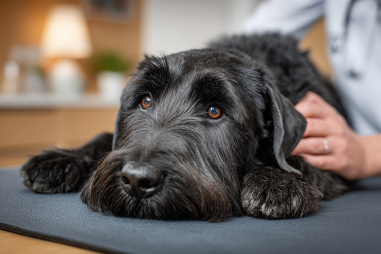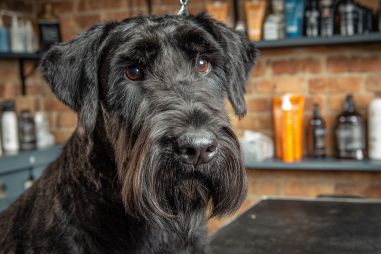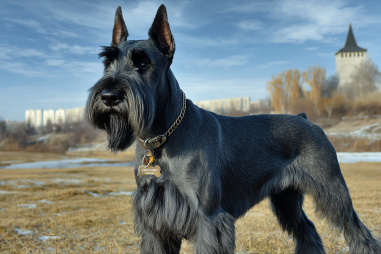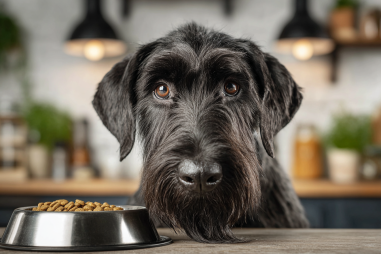Crate training is one of the most effective and humane methods to help your Giant Schnauzer develop good habits and feel secure in its environment. When done properly, crate training provides a safe haven for your dog, helps with housebreaking, reduces anxiety, and prevents destructive behaviors. This step-by-step guide will walk you through everything you need to know to introduce crate training in a positive and enjoyable way for your Giant Schnauzer.
Benefits of Crate Training
Before diving into the how-to of crate training, it’s important to understand why crate training is beneficial, especially for a powerful and intelligent breed like the Giant Schnauzer.
- Provides a Safe Space: A crate can be your dog’s personal den — a quiet, comfortable place where they can retreat for rest and relaxation. This sense of security is crucial for their mental well-being.
- Facilitates Housebreaking: Dogs naturally avoid soiling their sleeping area, so crate training helps teach your Giant Schnauzer bladder and bowel control, speeding up the potty training process.
- Prevents Destructive Behavior: Puppies and even adult dogs can get bored or anxious when unsupervised, leading to chewing or other unwanted habits. A crate helps prevent damage to your home and keeps your dog safe.
- Eases Travel and Vet Visits: Having your dog comfortable with a crate makes transportation, vet visits, or stays at the kennel less stressful for both you and your dog.
- Supports Separation Anxiety Management: When introduced gradually, crate training can reduce anxiety by offering a secure spot when you are away.
Choosing the Right Crate Size and Type
Selecting the perfect crate is the first practical step in crate training your Giant Schnauzer. Because they are a large, muscular breed, comfort and adequate space are paramount.
- Size: The crate should be large enough for your dog to stand, turn around, and lie down comfortably. For a Giant Schnauzer, look for crates designed for large breeds, often labeled for dogs 70 pounds and up. However, avoid a crate that is too big to prevent your dog from using one corner as a bathroom.
- Types of Crates:
- Wire Crates: Offer ventilation and visibility, making them a popular choice. They usually come with dividers, which allows you to adjust the crate size as your puppy grows.
- Plastic Crates: Offer more privacy and a cozy den-like environment. These are travel-friendly but less breathable than wire crates.
- Soft-sided Crates: Lightweight and portable but better suited for adult dogs who are already trained, as puppies might quickly chew through soft sides.
- Comfort and Safety: Add a soft crate pad or blanket for comfort, and ensure there are no sharp edges or loose parts that could hurt your dog.
Introducing Your Giant Schnauzer to the Crate
Introducing the crate should be a gradual, positive experience so your Giant Schnauzer associates it with safety and comfort rather than confinement or punishment.
- Start Slow: Place the crate in a common living area with the door open. Make it inviting by placing toys, blankets, and treats inside.
- Encourage Exploration: Allow your dog to approach the crate at their own pace. Toss treats or kibble inside the crate and praise them when they go in voluntarily.
- Meal Time in the Crate: Feeding your Giant Schnauzer inside the crate encourages positive associations. Start by placing the food bowl just inside the door and gradually move it deeper over time.
- Close the Door Briefly: Once your dog enters comfortably, try closing the door for a few seconds during meal times before opening it again. Gradually increase the duration as they become more relaxed.
- Stay Nearby: During these early moments, be close to reassure and speak calmly. This helps your dog realize the crate is safe and that you’re nearby.
Positive Reinforcement Techniques
Using positive reinforcement encourages your Giant Schnauzer to view the crate as a happy place rather than a punishment.
- Use Treats Smartly: Reward your dog with treats for entering the crate, staying calm, or lying down inside. Keep treats high-value and special to maintain motivation.
- Praise and Affection: Compliments, petting, and calm verbal encouragement reinforce good behavior inside the crate.
- Toys and Chews: Offer safe chew toys or puzzle feeders inside the crate to keep your dog entertained and foster positive associations.
- Avoid Negative Associations: Never use the crate as a place for punishment. This will create fear, making training more difficult.
Handling Common Crate Training Issues
Even with careful introduction and reinforcement, some challenges may arise. Here’s how to handle them effectively:
- Whining and Barking: This is common initially but should not be rewarded with attention as it reinforces the behavior. Wait for a pause in noise before letting your dog out, ensuring they understand quiet behavior gets rewards.
- Reluctance to Enter: Increase positive incentives and never force your dog. Try feeding meals in the crate and play games like tossing toys inside.
- Accidents in the Crate: Make sure the crate isn’t too large and limit the time your dog spends inside to prevent accidents due to full bladders or anxiety.
- Separation Anxiety: Start by leaving your dog in the crate with you at home for short periods and gradually increase your absence time.
Maintaining Crate Training Over Time
Once your Giant Schnauzer is comfortable with their crate, maintenance helps reinforce positive habits for the long term.
- Regular Use: Integrate crate time into your dog’s daily routine, such as during naps, bedtime, and when unsupervised.
- Continued Rewards: Occasionally reward your dog for calm crate behavior to sustain positive associations.
- Comfort and Cleanliness: Keep the crate clean and comfortable. Wash bedding regularly and check for wear on toys or crate parts.
- Adapt with Growth and Changes: Adjust the crate size as your Giant Schnauzer grows or if their needs change—larger crates for adults or smaller sections for puppies.
Crate training your Giant Schnauzer can be a rewarding journey that benefits both you and your dog. By choosing the right crate, introducing it patiently, using positive reinforcement, and managing challenges thoughtfully, you create a happy, safe space that your dog will voluntarily enjoy. Remember to be consistent, patient, and kind throughout the process, and you’ll soon see your Giant Schnauzer thriving in their crate sanctuary.







